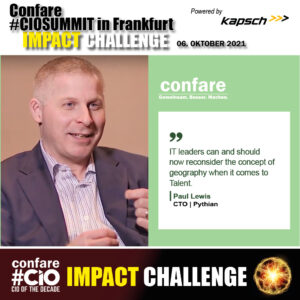Paul Lewis has not only worked successfully for many years as CTO and CIO of global companies. As an evangelist and role model, he has helped to further develop the CIOs role for the new demands of the digital world. He is now CTO at Pythian in Canada. In the run-up to the Confare CIO Impact Challenge, we wanted to hear from the global top manager what CIOs can contribute to making the world a better place.
How are your company and your industry affected by the Covid19 pandemic?
Paul Lewis: Like most companies, we were impacted by national and regional orders affecting in-person in-office working. Fortunately, we had the technology and culture in place as a global company to manage a workforce that was entirely shifted to Work-from-Home. We ensured technology existed to access bot the data and applications needed across a variety of departments, and already had the appropriate services for communication and collaboration in place.
Our new adventure was creating distinct relationships with clients in a wholly virtual setting. From greenfield interactions to long-term relationships, we learned how to effectively communicate with both customers and our ecosystem of delivery partners. It wasn’t always perfect, but we were all in the same boat, relaxing some of the formality that comes with presentations, especially with new clients.
What role has CIOs played in overcoming these challenges?
 CIO’s haven’t always been at the forefront of business change, but the pandemic has dramatically changed the role of CIO from what might have been “cost control” to growth or change focused depending on the industry. In real-time Technology and telecom CIO’s were focused on massive growth, travel and entertainment CIOs were focused on evolving IT to keep-the-lights-on and consumer and retail were changing entire supply chains and customer experience models. All this growth and change also had to be completed in a week, not months or years. New delivery models, new organizational models, and new key metrics were invested and reinvented in record time. Change has become a constant, and most of the technology change will be permanent.
CIO’s haven’t always been at the forefront of business change, but the pandemic has dramatically changed the role of CIO from what might have been “cost control” to growth or change focused depending on the industry. In real-time Technology and telecom CIO’s were focused on massive growth, travel and entertainment CIOs were focused on evolving IT to keep-the-lights-on and consumer and retail were changing entire supply chains and customer experience models. All this growth and change also had to be completed in a week, not months or years. New delivery models, new organizational models, and new key metrics were invested and reinvented in record time. Change has become a constant, and most of the technology change will be permanent.
To what extent has the role of internal IT changed in the wake of the corona crisis?
Internal IT has changed in substantial ways. Firstly, to accommodate a significant shift in work from home, an increase to the ITSM organization took place including increases to Service Desk and end-user support. From a project delivery perspective, digital transformation projects shifted into Agile mode in an attempt to deliver quick wins and quick customer experience changes, some for survivability, some to accommodate the lack of physical customer presence. Also, since security concerns have risen dramatically, the cybersecurity budgets, positioning, and capability have increases to handle.
How sustainable is the digitalization that took place in companies with the Corona crisis?
The changes implemented due to the pandemic have a long tail and are likely permanent. CEO’s will not wait quarters or years for technology projects. Clients won’t wait months for new features. Delivering in real-time will remain. Offices will reopen, but will focus less on “working” and focused more on “meeting”, becoming physical hubs for engagement and creativity versus a place just to hang your hat from 9-5 every day. Some people will return to the office, but most companies will maintain a default setting of working at home.
To what extent can IT leaders help make the world a better place?
IT leaders can and should now reconsider the concept of geography when it comes to Talent. You no longer should limit yourself to finding people near an office building and you can now look for talent across the country, region, and world. This will not only maximize the capability in the team but will reduce the overall people expense as your average compensation over greater distances and rely less on the accommodations of an office setting. Leaders must embrace the concept of shifting the culture from being centrally defined, to being federated throughout all employees maximizing regional differences. People should be able to work how they want, when they want, on whatever style maximizes their own personal productivity. Start measuring outcomes not process.
What are the prerequisites for successful cooperation between the CIO, HR, and Business?
Build real and personal relationships across departments. People work and trust other people, not titles or role levels.


